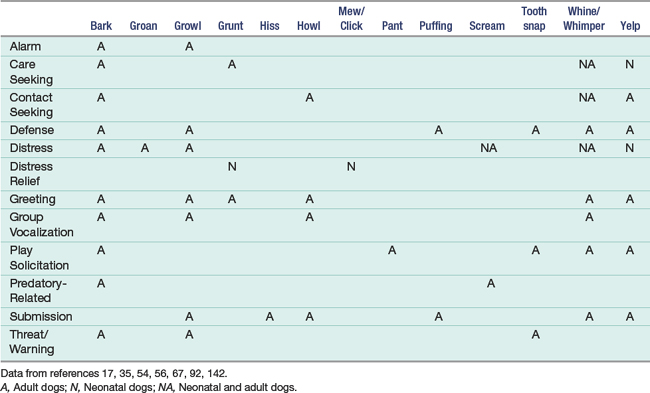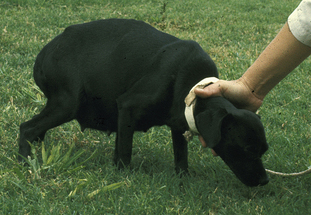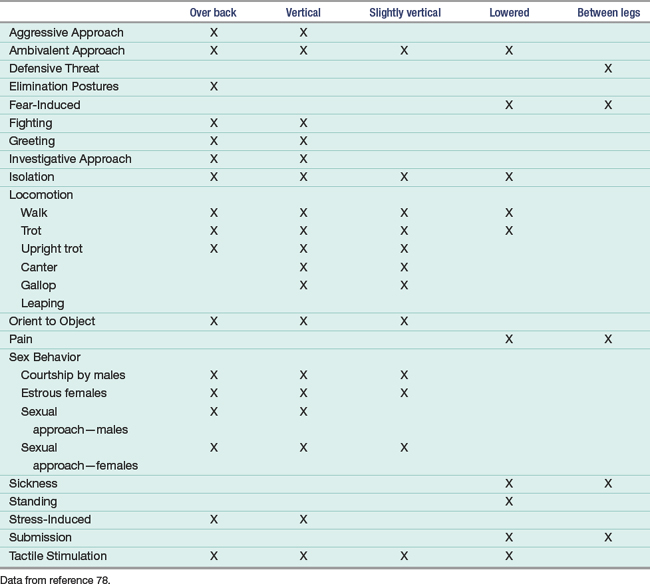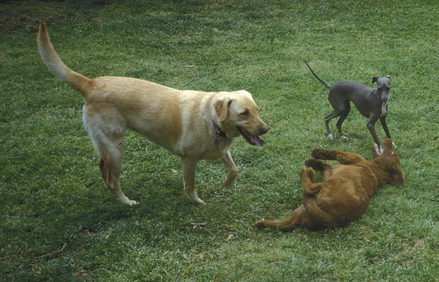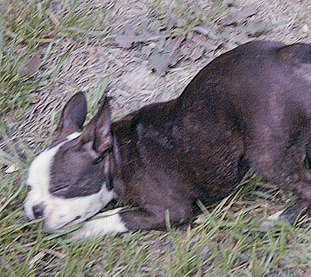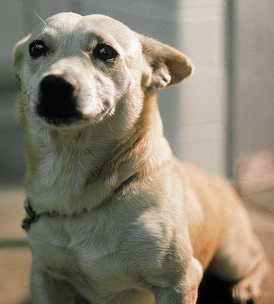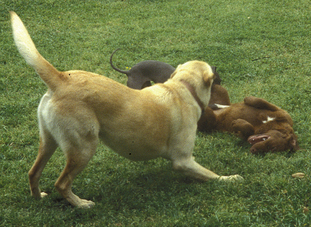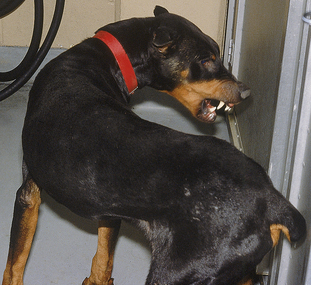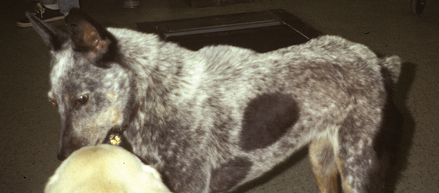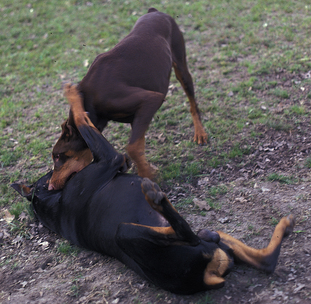CHAPTER 3 Canine Communicative Behavior
When humans think of communication, we usually think of the verbal form. For dogs, however, vocal communications are the least significant; body signals and odors are primary. The types of information transmitted also differ between the two species. Language allows specific messages. Without language, the messages are more general in nature, usually reflecting an emotional state.52 Because people use language to communicate with dogs, and because dogs understand generalities in vocal communication, it is important to be consistent in word and voice quality when giving commands.20 Many times the dog actually picks up on a body language message rather than a verbal one.
General messages can be given by dogs via vocal or silent communications, and mixed messages can be expressed as well.54 The agonistic message system includes six types of messages: territorial defense, advertisement, submission, defensive threat, offensive threat, dominance, and readiness to fight.107 The sexual message system includes five types of messages: male advertisement, female advertisement, courtship, synchronization and suppression, and copulatory signals.107 The most general category includes those messages commonly used in day-to-day routines: play, affiliation, assembly, identity, familiarization, solicitation, alarm, distress, and satisfaction.107 Even the youngest dogs give and receive messages. The neonatal message system includes infant distress, infant identity, infant affiliation, infant satisfaction, neonatal contact, maternal assembly, maternal identity, and maternal alarm.107
VOCAL COMMUNICATION
The dog has a variety of sounds for communication. Unlike its wolf relative, which uses only four to nine types of vocalizations,46 the dog is significantly more vocal, almost to the point of hypertrophic barking.30,44 This characteristic has been equated with paedomorphosis associated with the selective breeding of domestication. Excessive barking is considered a juvenile behavior.32
Puppies develop the vocal patterns of adult dogs gradually. A newborn puppy starts with three calls, two for distress and one for nondistress situations.17,54,107 Distress vocalizations—whines and yelps—have an et-epimeletic function to reunite the neonate and the bitch.48,56,117 The use of whines and yelps tends to increase, peaking at 7 to 9 days after birth, and they gradually decrease over the next 3 weeks.48 Use of the nonprotest grunt, mew, and clicking sounds is associated with relief of stress or relief of discomfort, contact with the bitch or littermates, and warmth.16,31 These sounds peak at 4 to 9 days and then gradually decrease until they are gone by 5 weeks of age.17,48 Around 4 weeks of age, the more adult-like phase of vocal communication begins, with some structural changes occurring after that.107
Distress vocalizations in young puppies have been well studied. They are characterized as a rapid series of whines and yelps occurring at rates that can exceed 100 per minute in 3-week-old puppies during situations of obvious discomfort.36,117 This frequency decreases with experience from repetition, but situational and genetic variations occur.
As puppies mature, they develop a larger repertoire of vocalizations. These can be described by acoustic signs,133 situational arousal, or type of sound. The later is described here.
Bark
Barking starts abruptly between 2 and 4 weeks of age,17,36,48,54,107 with most puppies showing a response as if they are startled by their first bark. Initially, barking occurs in a play-soliciting context and is not associated with serious aggression until after 8 weeks of age, when puppies will respond to their dam’s growl.17 Aggressive barks by puppies generally do not occur before 12 weeks.17 By the fourth month, the aggressive bark is more marked in defense of food and toward strange dogs, probably more as an announcement of presence rather than a warning.17
Different pitches indicate different situations, with the higher tones more for greetings and play and lower tones for threats. Because barks can carry a number of different messages, it is easier to put them into context when the dog’s body language can also be observed.17 Barks are most commonly associated with greeting, play solicitation, alarm, hunting, tracking, herding, vocal alerting, defense, threat, care seeking, distress, contact seeking, and group vocalization (Table 3-1).* Disturbances are associated with a harsh, low-frequency, unmodulated characteristic.95,143,144 It is longer in duration and has a more rapid repetition than barks for other reasons. Without knowing the context, 70% of people can identify this harsh bark as a bark of disturbance.143,144 They can also recognize barks from other general situations by general acoustic patterns.95,98,110,111 Owners who are around their dogs more are better at recognizing the tone of bark and the situation that prompts it. Certain breeds or lines pass on an inherited tendency to bark more often, but individuals can also learn to bark excessively through rewards.67 In contrast, wolf cubs bark a lot, but adult wolves do so only for alarm, threat, protest, while hunting and during pair behavior.118 Their barks are brief and infrequent.
Tone quality varies within a barking episode, and more than one message can be conveyed at a time.32 In general, barking is characterized as complex, wide-banded, segmented bursts of sound of 200 to 6000 Hz, with a mean of 650 Hz.17,32,54 These bursts last 0.2 second each,17 and they tend to be cyclic. The frequency of barks during an event ranges from one single bark to a continuous series. One Beagle barked 907 times in 10 minutes.32 In contrast, only 2.5% of the vocalizations of captive wolves were barks.32
Quantifying the frequency and duration of barking episodes is important to differentiate normal from abnormal. On average, dogs bark 3.1 (0 to 8) times in 24 hours when owners are home.47 Each episode lasts 50.9 (1 to 302) seconds for a total of 198 (0 to 430) seconds spent barking in that 24-hour period.47
Over two thirds of dogs in various urban habitats in one study barked during the night. Half of those barking dogs had five or more bouts of barking during the 8-hour period.1 When asleep, dogs apparently remain more alert to alarm barking than to other stimuli, even though the other types of stimuli might be of more significance to the owner.2 Individual dogs living in a group are more likely to bark than single individuals.2
Cough
Obviously coughing is usually associated with tracheobronchial irritations, but it occasionally can have a communication function. As in human communication, coughing-like sounds can be used by canids as a threat or warning.31 They can also be heard in defensive situations.
Groan
A groan is an acute distress call that has been described as sounding like a saw cutting wood or a snore.17 The fundamental pitch is 250 to 450 Hz, with the main harmonics at 500 to 700 Hz.17 The spectrogram shows a segmented rate of 125 per second, a duration of 0.06 second and a frequency of 15 per second.17
Growl
Whereas dog owners usually associate growling with an aggressive behavior of defense, warning, or threat, it usually is more complex than that (see Table 3-1). For example, growling can occur as a greeting, perhaps to reinforce dominance relationships.54 Play bouts between dogs or between dogs and humans may contain play growls in addition to the more traditional signals of play.
Growling usually occurs first during puppy play fights at approximately 24 days of age.17 At that time the fundamental pitch is 150 to 450 Hz, with poor harmonics to 3000 Hz.17 By 9 weeks, the fundamental play growls are more segmented, and the fundamental pitch is 150 to 300 Hz, with no harmonics.17 In adult dogs, it is difficult to define a fundamental pitch any longer; however, the energy level associated with growling remains.17,56 The pattern is noncyclic.56 Spectrograms of growls in various contexts show similar patterns regardless of the initiating factors.17
Grunt
Newborn puppies grunt as a nonprotest sound for greeting, care seeking, or contact.16,31,56 Initially, the sound starts between 250 and 1500 Hz,54 lasting 0.2 second at a rate of two grunts per second.16,17 The frequency and rate increase slightly by the second day. By 6 weeks, the sonogram pattern shows segmentation and a shorter duration.17 In adults, grunts are usually associated with the animal being stroked or held by its owner.17 Then the fundamental frequencies are 85 to 200 Hz.31
Hiss
The hiss is a mechanical sound of air being forced through the nose.17 It has been suggested that the hiss is a primitive predecessor of threat sounds.17
Howl
The howl is a canine vocalization that can both fascinate and annoy humans. In wolves, the howl is used by isolated individuals, perhaps as a long-distance vocalization.80,134,135 Members of a pack may join in a chorus of howls as a group vocalization.43 It has been shown that, for wolves at least, there are seasonal fluctuations in the number of howls. The number of elicited howls remains relatively constant over time, but the increase in spontaneous howls by pack members during the wolf’s breeding season correlates to the increase in frequency of howling by the alpha male.81 Thus, group howling may be a show of pack affinity, a display of strength, or a spontaneous vocalization. It can also be used as a warning and a show of group power toward strangers approaching a pack. A perimeter wolf will howl when it becomes aware of a stranger approaching.127 This howl gets the attention of the others in the pack, and all join in unison to stop the stranger’s advance.127 The closer the approach of the stranger, the deeper the pitch is of the howling, and the more harmonically unrelated frequency sidebands are added.64
In the modern dog, these wolf traits associated with howling may still be expressed. Contrary to popular opinion, dogs are probably not howling as the result of a noise hurting their ears. As described in Chapter 2, their hearing is not that much different from a human’s hearing. Instead, the pet dog that howls to the wailing siren may be responding to an approaching “stranger,” and the one that sings with its owner’s voice or musical instrument may be joining in the vocalization of others in its pack.
The harmonics of a howl are in the range of 400 to 2000 Hz for the fundamental frequency and 1200 to 2900 Hz for the dominant one.31,54 The lower frequencies are more prominent,56 and they are used most in situations in which a greater threat or warning is needed.64 The duration of a howl is greater than 1.0 second, and there are few variations of frequency during the howl.56 Although a howl may be repeated, it is not considered cyclic.56 In wolves, the voice quality is unique enough that individuals can be identified by their howl alone.64, 135
Mew/Click
The mew or click sound is made by distressed neonates when they are in pain or seek maternal or littermate contacts.31,56 These are short, wide-banded, cyclic sounds with moderate frequency variation.56
Pant
Noises of panting are not vocalizations of the larynx but rather of air movements of the oropharynx. In canine communication, they are associated with play solicitation.56
Puffing
Puffing can be described as the lowest-intensity aggressive vocalization, 17 and its origin is mechanical rather than from the vocal folds. The sound results when air is forced through a slightly opened mouth. The lip folds can be seen to move.17
Scream
The scream is used as a vocalization by both puppies and adults when they are distressed, in pain, or showing submission.31,56 Characteristically, these sounds are of great intensity and are wide banded, noncyclic, and long in duration.56 Great frequency variations exist, with a fundamental frequency of 1200 to 2700 Hz and a pitch of dominant frequency of 1800 to 3200 Hz.31,54
Tooth Snap
Another mechanical sound coming from the mouth is the tooth snap, made by teeth hitting each other as the jaw rapidly closes. The sound has been associated with play solicitation, defense, and threat behaviors.31,54
Whine/Whimper
Whines and whimpers can be associated with a number of different events, so they have a number of meanings, but they mainly signify distress.16,17 Situations that appear to provoke whines and whimpers can include care seeking, contact seeking, defense, distress, greeting, group vocalizations, pain, play solicitation, and submission.31,56 In newborns the pitch varies from 500 Hz to 1500 Hz, and the average duration is 1 second.16,17 The usual frequencies associated with the whine or whimper in older dogs are cyclic, ranging between 500 Hz and 3400 Hz. Clear harmonics exist at 1000-cycle intervals, and the duration decreases.16,17,54,56 The distress vocalizations in puppies as young as 8 days can exceed 100 per minute but average about 20 per minute in unfamiliar environments.129
One variation, the sex whine, is a vocalization of intact male dogs associated with a male being near a copulating pair, refused by or separated from an estrous female, or near a whelping bitch.17 The frequency for the sex whine ranges from 3250 Hz to 4200 Hz, with no harmonics.17
Yelp
The yelp begins to develop with the whine at 14 to 20 days of age.17,54 Initially, the combination will start at 1300 Hz, then drop to 800 Hz, with a duration of 0.2 to 0.3 second.17 From this will develop the more abrupt, bark-like yelps, with harmonics extending to 6000 Hz.17 True yelps first occur at 20 to 24 days of age.17 Yelps are associated with greetings and play solicitation, as well as with distress, pain, submission, contact seeking, and defense.54
Tone quality of yelps can cause different responses in other dogs. Short notes, especially of higher frequency, are more likely to increase motor activity levels than are long, low-frequency notes.88,89 Inhibitory signals tend to be prolonged and descending single notes.89
Vocalizations can occur alone, simultaneously with other vocalizations, or successively in various combinations. The pairs of vocalizations that occur simultaneously include the whine-bark, bark-scream, growl-whine, and bark-growl.31 Combinations that occur sequentially vary from the mew-grunt in puppies to whine-bark, whine-growl, whine-pant, bark-growl, growl-scream, and howl-bark in adults.31
Mutism is also possible in dogs. Experimentally, a mute can be created by bilateral destruction of the central gray matter beneath the superior colliculus.126
POSTURAL COMMUNICATION
Canids use a wide variety of genetically programmed body postures to communicate,68 and they are adept at reading subtle changes. Owners may think that their moods are sensed by their dogs without recognizing that their pets are actually reacting to specific human behavior. The “guilty” look of submission, for example, is more likely the dog’s response to the owner’s increased dominant postures than to remembering that it defecated in the house several hours earlier. Experimentally this ability of dogs to interpret, react to, and even rely on human gestures has been confirmed in a number of different ways.* The responses are also dependent on a moving image as compared to only a voice.109
Distance-Reducing (Submissive) Signals
Body signs that tend to decrease a threat or encourage an approach are classified as distance-reducing, or submissive, signals. Showing submission helps stop or attenuate aggression or punishment by a more dominant dog, 68 and puppies quickly learn the usefulness of these signals as appeasement gestures.124 It represents an effort by a lower ranking animal to attain a harmonic social integration and assumes that the higher ranking individual will respond appropriately.30,121 This type of communication can be broadly divided into three categories: passive submission, active submission, and play.9,12,52
Passive Submission
The body signals of passive submission are derived from postures the young adopt when being cleaned by their mother.121 These signals range from the very subtle to the very extreme.52 At the subtle end of the scale is the simplest of responses—that of avoiding direct eye contact. Progressively more obvious signs may follow in any order. The dog will tend to lower the ears back against the neck, and the head will be lowered as the neck is lowered and extended forward or twisted sideways (Fig. 3-1). The lowered ears, head, and neck for submission must be carefully interpreted to be consistent with other body signs because of the similarity with signals used by aggressive dogs. The tongue can flick in and out, or the more dominant animal may be licked in greeting.56,125 A submissive grin, with its horizontal retraction of the lips, may be observed.56 If the submissive dog is touched, it will hold completely still.
The tail is held lower, often between the legs, as an indicator of fear or submission. It may be wagged there (Table 3-2). Tail wagging has been equated with a human’s smile and can be used as an index of emotionality.78 Motion in the tail should be viewed cautiously though. The flagging of dominance, while stiffer, more upright, and more rigid, is still easily confused with the wagging of submission. One study indicated that the tail swings farther to the right in the presence of a person and to the left for an unfamiliar dog.113 Wolves wag their tails in much the same way as dogs. The limber tail indicates a friendly, possibly submissive message.82 This is almost always true if the wolf’s tail is wagged in a circle.82 Domestication has increased the tendency of the dog to use a tail wag.32,78 Dogs do differ from wolves in other ways, however. Overall their visual communicative repertoire is less complex, their facial displays more limited, and signals can vary by breed.125
The general aim of distance-reducing signals is to decrease any sign of threat, so the dog will gradually crouch into a lower position, perhaps raising a front paw (Fig. 3-2).48,56 A raised paw can also signal a defensive warding-off reaction or a play-soliciting behavior.56 The submissive dog may actually lie down (Fig. 3-3). It may then even roll over to expose the abdomen. Because the abdomen is the only body part not protected by bone, attack of it by a more dominant animal could be fatal. As a result, rolling over is an extremely submissive posture. In addition, the dog may urinate in submission. Some dogs will roll over onto their backs and present their abdomens to solicit “tummy rubs.” This is a submissive posture but one soliciting interactions. The difference is generally easily distinguished from the submissive message alone because the one’s seeking interactions will have their eyes wide open and be looking at the person from whom they want attention.
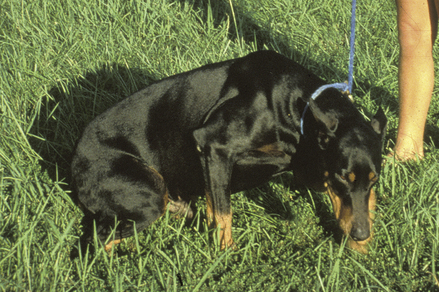
Figure 3-2 Crouching is another one of the body postures of submission.
(From reference 9. Used with permission of Veterinary Medicine Publishing Group.)
It is important to note that submissive postures are often associated with fear. In addition to the tendency to shrink in size, dogs may also tremble, freeze in place, or run away. There are physiologic changes of stress that can include increased salivary cortisol levels.13
A few dogs that are passively submissive will show the “mimic grin” facial expression (Fig. 3-4).9 The expression is easily confused with an aggressive one because of the bared teeth, but with the mimic grin, all other body signals indicate submission. Although some authors feel the mimic grin is a learned behavior,52 it is most likely an inherited submissive behavior, as it is common in certain bloodlines in both purebred and mixed-ancestry dogs. The “pleasure face,” or “grin,” 124 is another facial expression that does not carry a threat.52 This expression includes lips that are pulled back horizontally a little from normal, ears that are lowered, and eyelids that are half-closed (Fig. 3-5). A dog is most likely to show the pleasure face when it is scratching or rolling over odiferous things.
Active Submission
Individual dogs use active submission significantly more often than passive submission. This behavior pattern is derived from the puppy’s initial begging for milk and food, olfactory investigation, and receiving anogenital licking from the mother.30,78,121 The most distinguishing characteristic of active submission is the approach of the dog to a person or other dog. The approach is usually accompanied initially by the head and tail held high as the dog bounds forward. Tail wagging is common when a dog greets a social peer or superior.78 Once the dog has reached its goal, it will show one or more signs of passive submission: diverted eyes, lowered head, immobile response to touch, submissive urination. Shortly after acknowledgment, the dog may bound around again.
The “greeting grin” is associated with active submission (Fig. 3-6).9, 52 This facial expression resembles a human smile, with the corners of the mouth pulled back.52 It is seen only in human-dog interactions, not in dog-dog ones.53
Play
Adult dogs maintain specific postures for play solicitation. The front-end-lowered rear-end-up position of play intention posture, called the play bow, is well recognized (Fig. 3-7).9 It is significant that adult dogs use a specific posture associated with play intention to be sure that the context that follows is not confused with other intentions, such as aggression.14,124 This play bow is usually followed after approximately one third of a second by a quick return to a standing position14 and then by some jumping around the intended playmate. Play activity involves rapid and exaggerated movements.125 This behavior is first used at about 23 days of age.14 The posture is rarely used outside the context of play, but occasionally there is a dog that solicits play with the play bow and then attacks.69
A raised forepaw can be a play-solicitation gesture.56,125 The context in which it is displayed is important to its interpretation. Other play solicitation behaviors include open mouth panting, running off while looking back, and exaggerated loping (leaping) approaches.19,87
Humans can also use canine postures to solicit playful interactions with a dog. A play bow posture and a “lunge” often result in play, including an increase in play bout frequency and mean duration.115,116 Adding play vocalizations increases both even more.115
The “play face” expression is an intensification of the greeting grin.52, 56 The ears are erect and forward, anatomy permitting, and panting may occur. At the same time, the tail is often high and wagging while the front is in the play bow.52
Distance-Increasing (Agonistic, Aggressive, Dominant) Signals
Body postures that appear to increase the size of an individual by optical illusion are meant to convey a “go away” message. As with submissive postures, signals intended to increase a dog’s threat come on a graduated scale and diverge in opposite directions. Although submission involves a reduction in size and use of a soft whine, a threat involves increasing body size and a loud vocalization.125 The tendency is for displays to begin as subtle messages and increase if necessary; however, a dog can mix signals in any order of presentation.10,125
Nine behaviors have been described as agonistic signals observed in wolves.51,58 These include the growl, displacement (moving the opponent away), standing over, inhibited bite, standing erect, body wrestling, aggressive gape, bared teeth (snarl), and stare. These are also behaviors seen in dogs, but not in all breeds of dogs. Breeds that are physically, and perhaps evolutionarily, closer to wolves show more of the behaviors, whereas breeds more physically dissimilar show progressively fewer of the signals.58 Behavioral paedomorphism parallels physical paedomorphism.58
Direct eye contact, with eyelids wide open—the stare—is the most subtle of threats but one generally recognized among dogs. Its use effectively settles disputes between most dogs, minimizing the need for escalation of the confrontation and reducing the potential for life-threatening injuries. The mouth shows the next signals when the lips are pulled back at the corners and eventually retracted vertically into a snarl (bared teeth) (Fig. 3-8).56 The aggressive gape also shows teeth, but adds a partially open mouth.51 The head, neck, and ears are elevated during the initial phases of distance-increasing communication, but as the threat becomes more intense, they may be lowered.52 This is to protect the throat and ear pinnas during an actual attack. This lowered position can resemble the posture of passive submission, but each leads to a very different next step.
The dog will create the illusion of increasing size. First the weight is shifted forward to indicate a strong position. Then the legs and toes are stiffened (standing erect) to maximize what length is there. Piloerection of the hairs over the shoulders and rump also creates a deceptive sudden increase in height, especially in dogs with longer hair (Fig. 3-9). These postures are used for threat aversion, indicating high arousal, not necessarily dominance.124 Dogs showing fear tend to have hair raised in two areas—over the shoulders and over the rump—whereas a dominant dog has it raised all the way down its back.101 The tail is held vertically or arched over the back, where it can be flagged in either a slow, deliberate motion or a rapid motion in which it is almost vibrating back and forth (see Table 3-2).10,52 The relative height of the tail gives a good indication of the level of confidence of the dog78 and of the relative dominance between individual dogs (Fig. 3-10). Confusion about the meaning of a vertical tail can result because this is also a behavior of excitement.52
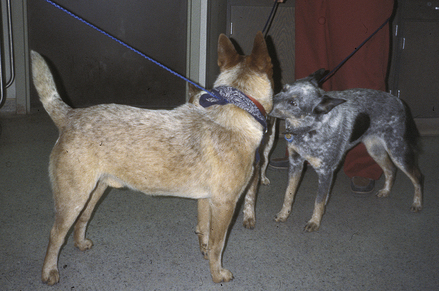
Figure 3-10 Two Blue Heelers show a facial-lingual approach, one with a vertical tail and the other with a tucked tail.
At any stage of posturing to create a distance-increasing message, a male dog may go over to an object to urinate on it, perhaps even scraping the ground afterward. During this time, however, the stare, piloerection, and other distance-increasing signs are maintained.52
Ultimately, the distance-increasing signals can escalate until they approach an actual attack.52 The dog may show an inhibited bite (bite-intention movement or snap) as a warning or threat.52 Biting into the victim and holding on, with or without the head shake, is the primary method of fighting, and the ultimate position in the fight is to achieve a firm grip on the ventral neck (Fig. 3-11). This neck-grip position is used in fights between dogs and for bringing down prey.
< div class='tao-gold-member'>
Stay updated, free articles. Join our Telegram channel

Full access? Get Clinical Tree


